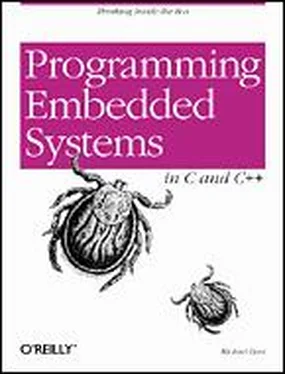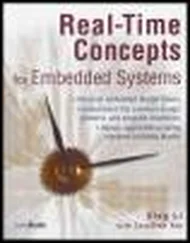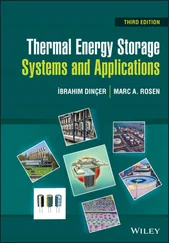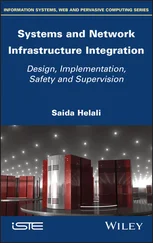assembler
A software development tool that translates human-readable assembly language programs into machine-language instructions that the processor can understand and execute.
assembly language
A human-readable form of a processor's instruction set. Most processor-specific functions must be written in assembly language.
binary semaphore
A type of semaphore that has only two states. Also called a mutex .
board support package
Part of a software package that is processor- or platform-dependent. Typically, sample source code for the board support package is provided by the package developer. The sample code must be modified as necessary, compiled, and linked with the rest of the software package.
breakpoint
A location in a program at which execution is to be stopped and control of the processor switched to the debugger . Mechanisms for creating and removing breakpoints are provided by most debugging tools.
CISC
Complex Instruction Set Computer. Describes the architecture of a processor family . CISC processors generally feature variable-length instructions and multiple addressing formats, and contain only a small number of general-purpose registers . Intel's 80x86 family is the quintessential example of CISC. Contrast with RISC .
CPU
Central Processing Unit. The part of a processor that executes instructions.
compiler
A software development tool that translates high-level language programs into the machine-language instructions that a particular processor can understand and execute.
context
The current state of the registers and flags of the processor .
context switch
The process of switching from one task to another in a multitasking operating system. A context switch involves saving the context of the running task and restoring the previously saved context of the other. The piece of code that does this is necessarily processor-specific .
counting semaphore
A type of semaphore that is used to track multiple resources of the same type. An attempt to take a counting semaphore is blocked only if all of the available resources are in use. Contrast with binary semaphore .
critical section
A block of code that must be executed in sequence and without interruption to guarantee correct operation of the software. See also race condition .
cross-compiler
A compiler that runs on a different platform than the one for which it produces object code . A cross-compiler runs on a host computer and produces object code for the target .
DMA
Direct Memory Access. A technique for transferring data directly between two peripherals (usually memory and an I/O device) with only minimal intervention by the processor . DMA transfers are managed by a third peripheral called a DMA controller.
DRAM
Dynamic Random-Access Memory. A type of RAM that maintains its contents only as long as the data stored in the device is refreshed at regular intervals. The refresh cycles are usually performed by a peripheral called a DRAM controller.
DSP
See digital signal processor.
data bus
A set of electrical lines connected to the processor and all of the peripherals with which it communicates. When the processor wants to read (or write) the contents of a memory location or register within a particular peripheral, it sets the address bus pins appropriately and receives (or transmits) the contents on the data bus.
deadline
The time by which a particular set of computations must be completed. See also real-time system .
deadlock
An unwanted software situation in which an entire set of tasks is blocked, waiting for an event that only a task within the same set can cause. If a deadlock occurs, the only solution is to reset the system. However, it is usually possible to prevent deadlocks altogether by following certain software design practices.
debug monitor
A piece of embedded software that has been designed specifically for use as a debugging tool. It usually resides in ROM and communicates with a debugger via a serial port or network connection. The debug monitor provides a set of primitive commands to view and modify memory locations and registers , create and remove breakpoints , and execute your program. The debugger combines these primitives to fulfill higher-level requests like program download and single-step.
debugger
A software development tool used to test and debug embedded software. The debugger runs on a host computer and connects to the target through a serial port or network connection. Using a debugger, you can download software to the target for immediate execution. You can also set breakpoints and examine the contents of specific memory locations and registers .
device driver
A software module that hides the details of a particular peripheral and provides a high-level programming interface to it.
device programmer
A tool for programming nonvolatile memories and other electrically programmable devices. Typically, the programmable device is inserted into a socket on the device programmer and the contents of a memory buffer are then transferred into it.
digital signal processor
A device that is similar to a microprocessor , except that the internal CPU has been optimized for use in applications involving discrete-time signal processing. In addition to standard microprocessor instructions, DSPs usually support a set of complex instructions to perform common signal-processing computations quickly. Common DSP families are TI's 320Cxx and Motorola's 5600x series.
EEPROM
Electrically Erasable, Programmable Read-Only Memory. (Pronounced "double-E PROM.") A type of PROM that can be erased electronically.
EPROM
Erasable, Programmable Read-Only Memory. A type of PROM that can be erased by exposing it to ultraviolet light. Once erased, an EPROM can be reprogrammed with the help of a device programmer .
embedded system
A combination of computer hardware and software, and perhaps additional mechanical or other parts, designed to perform a specific function. Contrast with general-purpose computer .
emulator
Short for In-Circuit Emulator (ICE). A debugging tool that takes the place of — emulates — the processor on your target board. Emulators frequently incorporate a special "bond-out" version of the target processor that allows you to observe and record its internal state as your program is executing.
executable
A file containing object code that is ready for execution on the target . All that remains is to place the object code into a ROM or download it via a debugging tool.
firmware
Embedded software that is stored as object code within a ROM. This name is most common among the programmers of digital signal processors .
Читать дальше












